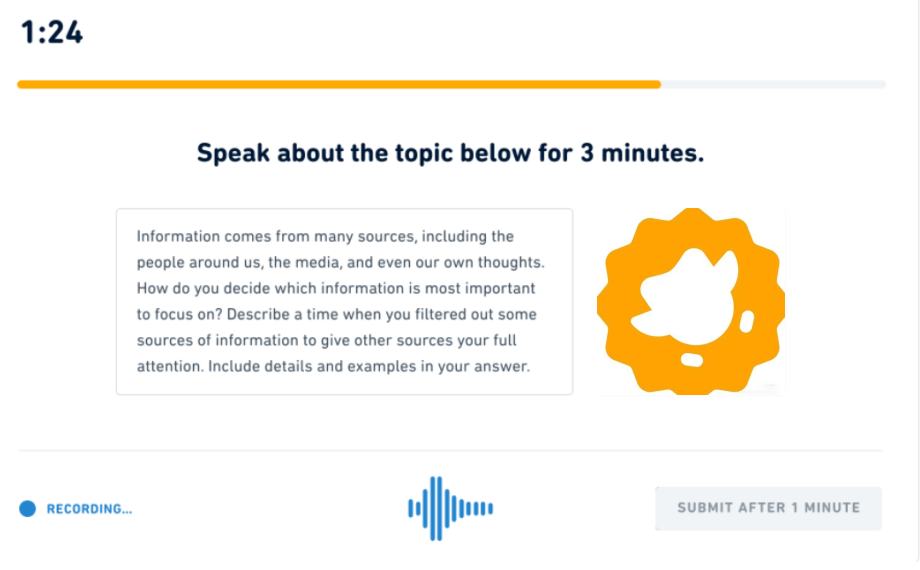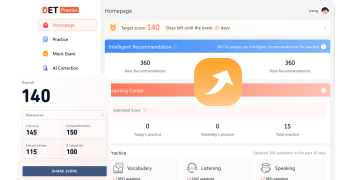Duolingo English Test Question Type Intro 3:Speaking Sample
The Speaking Sample is one of the important question types in the Duolingo English Test, requiring you to describe and respond to a topic within three minutes.
Understanding the "Speaking Sample" Question Type
The Speaking Sample in the Duolingo English Test is a crucial part that assesses candidates' proficiency in spoken English. Candidates are given 30 seconds to prepare an outline, after which the recording automatically begins and lasts for a maximum of 3 minutes. The Speaking Sample is evaluated based on several criteria, including content relevance, coherence, vocabulary variety and complexity, grammatical accuracy and sophistication, fluency, and clarity of pronunciation. Responses are recorded and cannot be re-recorded, and they are submitted to the institutions to which candidates are applying, along with their test scores. This section not only evaluates candidates' speaking skills but also provides a comprehensive assessment of their overall language proficiency.

The Temporal Approach: A Comprehensive Speaking Strategy
This versatile speaking technique is applicable to a wide range of oral assessments and conversation scenarios. The method revolves around structuring your responses by considering three distinct time frames: your past experiences, current situations, and future expectations related to the given topic.
When formulating your answer, it's crucial to ensure that your points are directly relevant to the specific subject matter. For example, if you're asked to discuss a recent favorite movie during a language proficiency test, you can effectively employ this strategy by describing a film you enjoyed in the past, one you're currently watching, and another you're looking forward to seeing soon.
This approach helps you maintain focus on the central theme while providing a more comprehensive context for your response. While not mandatory, this technique is an excellent tool for adding depth and breadth to your spoken answers. By incorporating this method, you can deliver more nuanced and engaging responses, potentially improving your performance in speaking assessments.
The temporal approach encourages you to draw connections between your personal experiences and the topic at hand, allowing for a more natural and fluid conversation. It also demonstrates your ability to think critically about a subject from multiple perspectives, showcasing your language skills and thought processes.
By considering the past, present, and future aspects of a topic, you can create a well-rounded response that not only answers the immediate question but also provides additional insights and engagement. This strategy can be particularly useful in situations where you need to elaborate on a topic or when you want to showcase your ability to think broadly about a subject.
Enhancing Your Narrative: The Six-Point Approach to Effective Communication
A powerful technique for crafting comprehensive and well-structured responses is the Six-Point Approach, which addresses the key elements of any story or explanation. This method helps you organize your thoughts and present information in a clear, logical manner. Let's explore how to implement this strategy in your communications:
l Core Subject: Start by introducing the central topic or event you're discussing. For example, if you're describing a culinary adventure, begin with an overview of the cuisine or dining experience you encountered.
l Temporal Context: Provide a timeline for your narrative. This could be a precise date, a general timeframe, or a contextual period, such as "during the holiday season" or "throughout my graduate studies."
l Geographical Setting: Specify the location of your story. This might be a particular city, country, or even a specific venue, like "in the heart of Tokyo's bustling Shibuya district" or "at a quaint countryside vineyard."
l Key Players: Identify the individuals involved in your account. This could include yourself, companions, family members, or other relevant participants, such as "I embarked on this journey with my colleagues" or "I attended the workshop alongside industry experts."
l Underlying Motivation: Sheds light on the reasons or incentives behind the event or action. This helps listeners understand your perspective and intentions, for instance, "to broaden my cultural horizons" or "in pursuit of professional growth."
l Procedural Details: Describe how the event or activity unfolded. This section can outline the steps you took or the process you followed, such as "we began our tour with a local guide, then explored hidden gems off the beaten path."
By incorporating these six elements into your responses, you'll create a more engaging and informative narrative that captures your audience's attention and provides a comprehensive understanding of your experiences or ideas.
Ultimately, regardless of the approach taken, candidates who want to achieve a high-scoring response in three minutes must prepare thoroughly in advance, paying close attention to question types and time management. Our website not only offers practice for all question types in the Duolingo English Test but also provides mock exams to help candidates enhance their skills more effectively.






